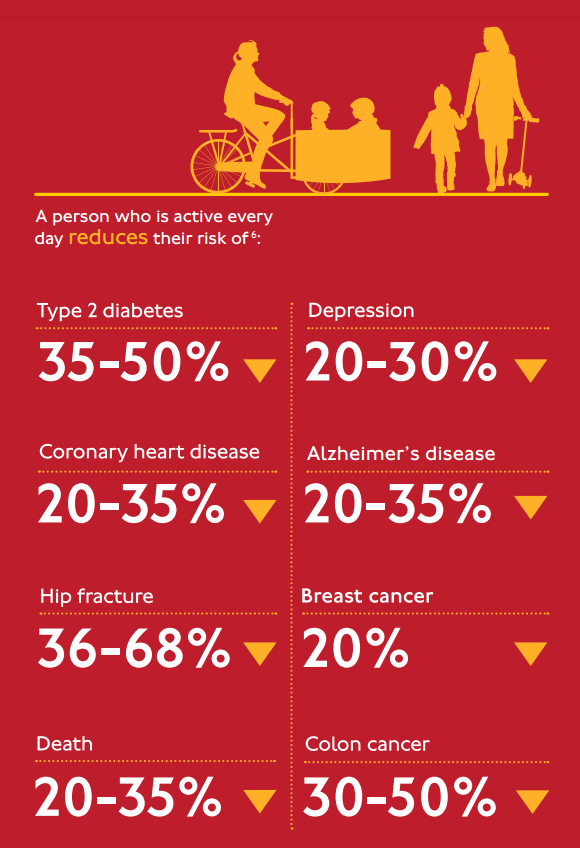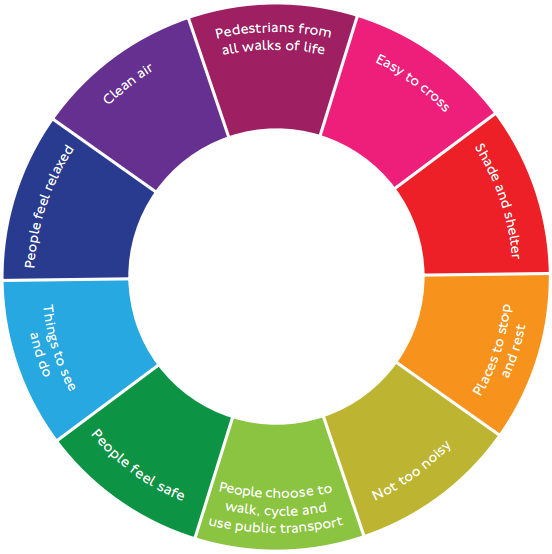Healthy Streets for London, published last month by Transport for London, is an important document which outlines in broad terms the strategy that will be adopted by the Mayor of London and his Walking and Cycling Commissioner in order to increase "active travel" by people living and working in London.
 The health benefits of daily activity are shown in the diagram. Conversely, the disbenefits stemming from current inadequate amounts of activity among the general population are increased frequency of these diseases, with consequent effects on friends and relatives, employers and increased NHS costs.
The health benefits of daily activity are shown in the diagram. Conversely, the disbenefits stemming from current inadequate amounts of activity among the general population are increased frequency of these diseases, with consequent effects on friends and relatives, employers and increased NHS costs.
"Active travel" includes not just journeys on foot or by bike, but also travel by public transport, since even the fairly short walks to and from bus stops and stations show health benefits when compared with door-to-door car journeys. The strategy therefore will use measures designed to make all three travel modes pleasanter and more convenient.
To quote from the introduction:
Almost without realising it, we have engineered physical activity out of our daily lives. The consequences of this shift to more sedentary lifestyles are severe. Lack of physical activity is now one of the biggest threats to our health, increasing the risk of developing a range of chronic diseases including diabetes, dementia, depression and the two biggest killers in London – heart disease and cancer.
We urgently need to design physical activity back into our everyday lives. Active travel – walking more, cycling more, using public transport more – provides the easiest and most affordable way for us all to get more active and live healthier lives. In addition to these health benefits, all the evidence shows that more active travel will reduce air and noise pollution, help combat social isolation, ease congestion, make us safer and bring economic benefits to businesses – large and small – across the Capital.
The success of the Healthy Streets strategy will be measured in terms of the ten indicators listed in the box at the end of this article.
Healthy Streets for London is available online at content.tfl.gov.uk/healthy-streets-for-london.pdf
Healthy Streets Indicators

Pedestrians from all walks of life
London’s streets should be welcoming places for everyone to walk, spend time in and engage in community life.
People choose to walk, cycle and use public transport
Walking and cycling are the healthiest and most sustainable ways to travel, either for whole trips or as part of longer journeys on public transport. A successful transport system encourages and enables more people to walk and cycle more often. This will only happen if we reduce the volume and dominance of motor traffic and improve the experience of being on our streets.
Clean air
Improving air quality delivers benefits for everyone and reduces unfair health inequalities.
People feel safe
The whole community should feel comfortable and safe on our streets at all times. People should not feel worried about road danger or experience threats to their personal safety.
Not too noisy
Reducing the noise impacts of motor traffic will directly benefit health, improve the ambience of street environments and encourage active travel and human interaction.
Easy to cross
Making streets easier to cross is important to encourage more walking and to connect communities. People prefer direct routes and being able to cross streets at their convenience. Physical barriers and fast moving or heavy traffic can make streets difficult to cross.
Places to stop and rest
A lack of resting places can limit mobility for certain groups of people. Ensuring there are places to stop and rest benefits everyone, including local businesses, as people will be more willing to visit, spend time in, or meet other people on our streets.
Shade and shelter
Providing shade and shelter from high winds, heavy rain and direct sun enables everybody to use our streets, whatever the weather.
People feel relaxed
A wider range of people will choose to walk or cycle if our streets are not dominated by motorised traffic, and if pavements and cycle paths are not overcrowded, dirty, cluttered or in disrepair.
Things to see and do
People are more likely to use our streets when their journey is interesting and stimulating, with attractive views, buildings, planting and street art and where other people are using the street. They will be less dependent on cars if the shops and services they need are within short distances so they do not need to drive to get to them



